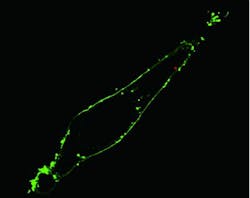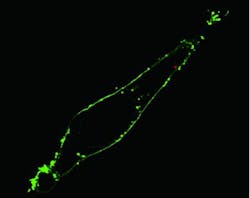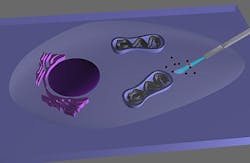Single-cell endoscope enables optical look inside living cells
Researchers with the U.S. Department of Energy (DOE)âs Lawrence Berkeley National Laboratory (Berkeley Lab; Berkeley, CA) have developed an endoscope that can provide high-resolution optical images of the interior of a single living cell, or precisely deliver genes, proteins, therapeutic drugs, or other cargo without injuring or damaging the cell. This nanowire-based optical probe could also be applied to biosensing and single-cell electrophysiology.
A team of researchers from Berkeley Lab and the University of CaliforniaâBerkeley attached a tin oxide nanowire waveguide to the tapered end of an optical fiber to create a novel endoscope system. Light traveling along the optical fiber can be effectively coupled into the nanowire, where it is re-emitted into free space when it reaches the tip. The nanowire tip is extremely flexible due to its small size and high aspect ratio, yet can endure repeated bending and buckling so that it can be used multiple times.
Combining nanowire waveguides and fiber-optic fluorescence imaging enabled the researchers to manipulate light at the nanoscale inside living cells for studying biological processes within single living cells with high spatial and temporal resolution, says Peidong Yang, a chemist with Berkeley Labâs Materials Sciences Division, who led the work. The team has shown that their nanowire-based endoscope can also detect optical signals from subcellular regions and, through light-activated mechanisms, can deliver payloads into cells with spatial and temporal specificity, he says.
To test their nanowire endoscope as a local light source for subcellular imaging, the team optically coupled it to an excitation laser and then waveguided blue light across the membrane and into the interiors of individual HeLa cells.
The optical output from the endoscope emission was closely confined to the nanowire tip and thereby offered highly directional and localized illumination, says Yang. Inserting the team's tin oxide nanowire into the cell cytoplasm did not induce apoptosis (cell death), significant cellular stress, or membrane rupture. What's more, illuminating the intracellular environment of HeLa cells with blue light using the nanoprobe did not harm the cells because the illumination volume was down to the picoliter scale, he says.
Having demonstrated the biocompatibility of their nanowire endoscope, the team next tested its capabilities for delivering payloads to specific sites inside a cell. While carbon and boron nitride nanotube-based single-cell delivery systems have been reported, these systems suffer from delivery times that range from 20 to 30 minutes, plus a lack of temporal control over the delivery process. To overcome these limitations, the team attached quantum dots to the tin oxide nanowire tip of their endoscope using photoactivated linkers that can be cleaved by low-power ultraviolet radiation. Within one minute, their functionalized nanowire endoscope was able to release its quantum dot cargo into the targeted intracellular sites.
Confocal microscopy scanning of the cell confirmed that the quantum dots were successfully delivered past the fluorescently labeled membrane and into the cytoplasm, says Yang. Photoactivation to release the dots had no significant effect on cell viability, he says.
The highly directional blue laser light was used to excite one of two quantum dot clusters that were located only 2 µm apart. With the tight illumination area and small separation between the light source and the dots, low background fluorescence and high imaging contrast were ensured.
Yang says that his team's nanowire endoscope could also be used to electrically or optically stimulate a living cell someday. The nanowires used in these experiments were originally developed to study size-dependent novel electronic and optical properties for energy applications.
The DOE Office of Science and a grant from the National Institutes of Health supported this work, which has been published in Nature Nanotechnology. For more information, please visit http://www.nature.com/nnano/journal/vaop/ncurrent/full/nnano.2011.226.html.
-----
Follow us on Twitter, 'like' us on Facebook, and join our group on LinkedIn
Follow OptoIQ on your iPhone; download the free app here.
Subscribe now to BioOptics World magazine; it's free!



